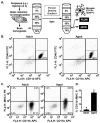Peripheral lipopolysaccharide (LPS) challenge promotes microglial hyperactivity in aged mice that is associated with exaggerated induction of both pro-inflammatory IL-1beta and anti-inflammatory IL-10 cytokines
- PMID: 18814846
- PMCID: PMC2692986
- DOI: 10.1016/j.bbi.2008.09.002
Peripheral lipopolysaccharide (LPS) challenge promotes microglial hyperactivity in aged mice that is associated with exaggerated induction of both pro-inflammatory IL-1beta and anti-inflammatory IL-10 cytokines
Abstract
In the elderly, systemic infection is associated with an increased frequency of behavioral and cognitive complications. We have reported that peripheral stimulation of the innate immune system with lipopolysaccharide (LPS) causes an exaggerated neuroinflammatory response and prolonged sickness/depressive-like behaviors in aged BALB/c mice. Therefore, the purpose of this study was to determine the degree to which LPS-induced neuroinflammation was associated with microglia-specific induction of neuroinflammatory mediators. Here, we show that peripheral LPS challenge caused a hyperactive microglial response in the aged brain associated with higher induction of inflammatory IL-1beta and anti-inflammatory IL-10. LPS injection caused a marked induction of mRNA expression of both IL-1beta and IL-10 in the cortex of aged mice compared to adults. In the next set of studies, microglia (CD11b(+)/CD45(low)) were isolated from the brain of adult and aged mice following experimental treatments. An age-dependent increase in major histocompatibility complex (MHC) class II mRNA and protein expression was detected in microglia. Moreover, peripheral LPS injection caused a more pronounced increase in IL-1beta, IL-10, Toll-like receptor (TLR)-2, and indoleamine 2,3-dioxygenase (IDO) mRNA levels in microglia isolated from aged mice than adults. Intracellular cytokine protein detection confirmed that peripheral LPS caused the highest increase in IL-1beta and IL-10 levels in microglia of aged mice. Finally, the most prominent induction of IL-1beta was detected in MHC II(+) microglia from aged mice. Taken together, these findings provide novel evidence that age-associated priming of microglia plays a central role in exaggerated neuroinflammation induced by activation of the peripheral innate immune system.
Figures






References
-
- Allan SM, Tyrrell PJ, Rothwell NJ. Interleukin-1 and neuronal injury. Nat Rev Immunol. 2005;5(8):629–40. - PubMed
-
- Amaral ME, Barbuio R, Milanski M, Romanatto T, Barbosa HC, Nadruz W, Bertolo MB, Boschero AC, Saad MJ, Franchini KG, Velloso LA. Tumor necrosis factor-alpha activates signal transduction in hypothalamus and modulates the expression of pro-inflammatory proteins and orexigenic/anorexigenic neurotransmitters. J Neurochem. 2006;98(1):203–12. - PubMed
-
- Barrientos RM, Higgins EA, Biedenkapp JC, Sprunger DB, Wright-Hardesty KJ, Watkins LR, Rudy JW, Maier SF. Peripheral infection and aging interact to impair hippocampal memory consolidation. Neurobiol Aging. 2006;27(5):723–32. - PubMed
-
- Basak C, Pathak SK, Bhattacharyya A, Mandal D, Pathak S, Kundu M. NF-kappaB- and C/EBPbeta-driven interleukin-1beta gene expression and PAK1-mediated caspase-1 activation play essential roles in interleukin-1beta release from Helicobacter pylori lipopolysaccharide-stimulated macrophages. J Biol Chem. 2005;280(6):4279–88. - PubMed
Publication types
MeSH terms
Substances
Grants and funding
LinkOut - more resources
Full Text Sources
Other Literature Sources
Medical
Research Materials
Miscellaneous

